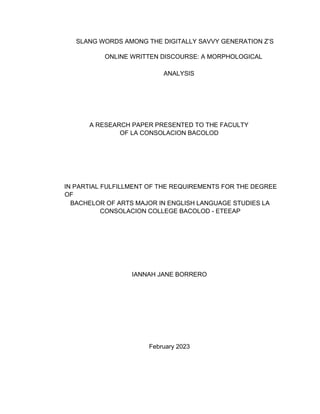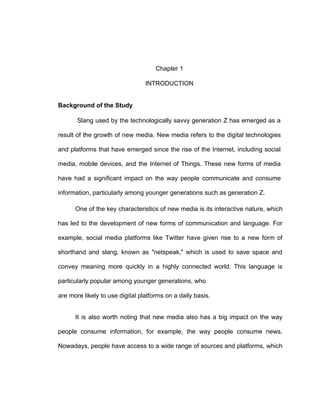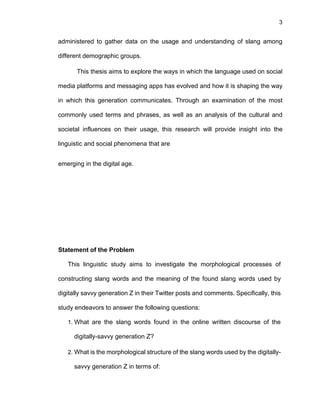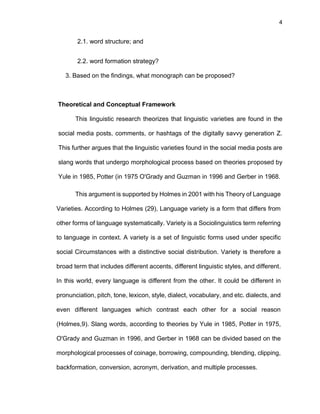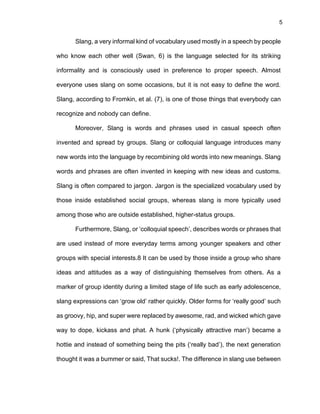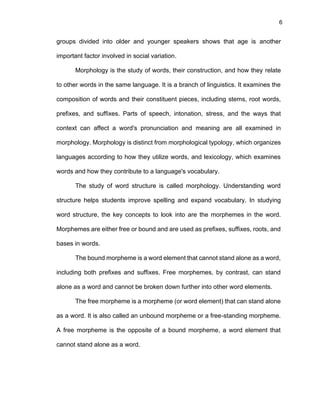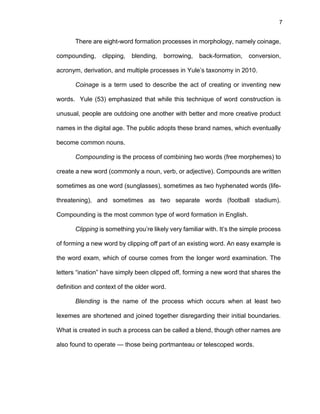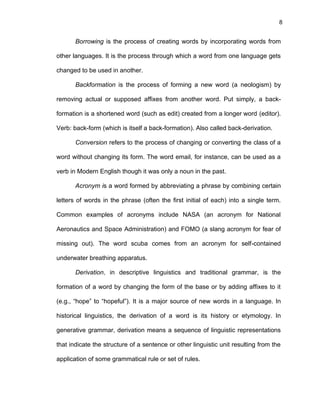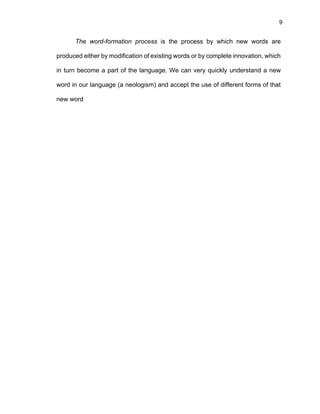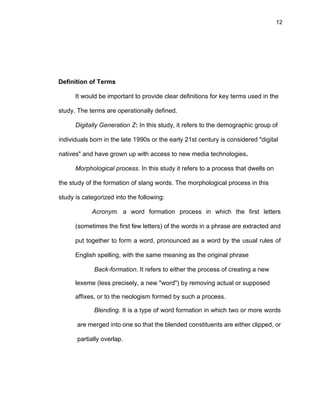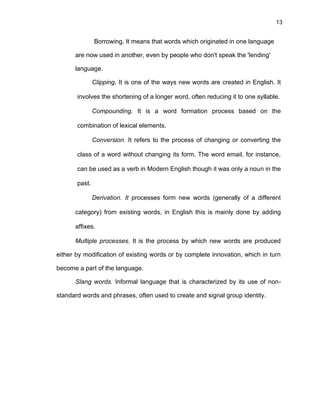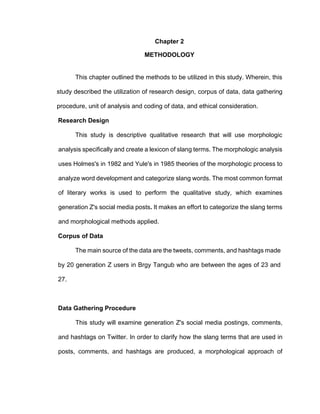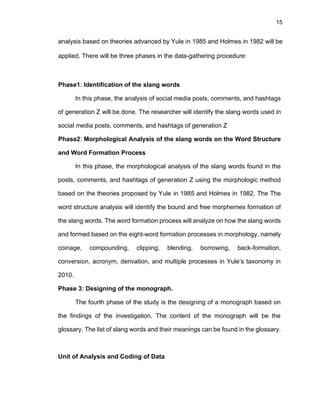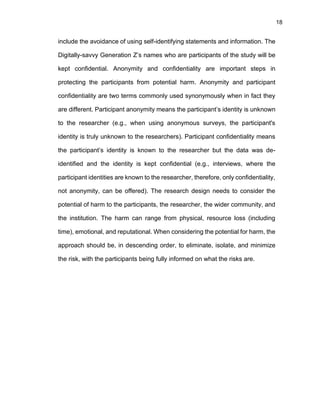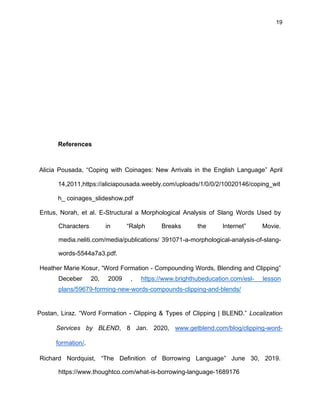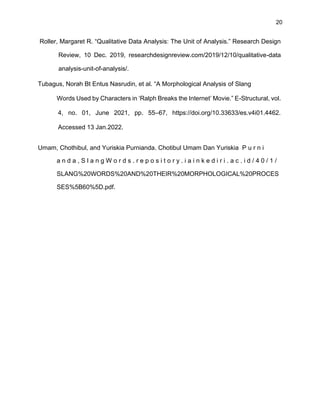BORRERO-SLANG-WORDS.pdf
- 1. 0 SLANG WORDS AMONG THE DIGITALLY SAVVY GENERATION ZÔÇÖS ONLINE WRITTEN DISCOURSE: A MORPHOLOGICAL ANALYSIS A RESEARCH PAPER PRESENTED TO THE FACULTY OF LA CONSOLACION BACOLOD IN PARTIAL FULFILLMENT OF THE REQUIREMENTS FOR THE DEGREE OF BACHELOR OF ARTS MAJOR IN ENGLISH LANGUAGE STUDIES LA CONSOLACION COLLEGE BACOLOD - ETEEAP IANNAH JANE BORRERO February 2023
- 2. 1 Chapter 1 INTRODUCTION Background of the Study Slang used by the technologically savvy generation Z has emerged as a result of the growth of new media. New media refers to the digital technologies and platforms that have emerged since the rise of the Internet, including social media, mobile devices, and the Internet of Things. These new forms of media have had a significant impact on the way people communicate and consume information, particularly among younger generations such as generation Z. One of the key characteristics of new media is its interactive nature, which has led to the development of new forms of communication and language. For example, social media platforms like Twitter have given rise to a new form of shorthand and slang, known as "netspeak," which is used to save space and convey meaning more quickly in a highly connected world. This language is particularly popular among younger generations, who are more likely to use digital platforms on a daily basis. It is also worth noting that new media also has a big impact on the way people consume information, for example, the way people consume news. Nowadays, people have access to a wide range of sources and platforms, which
- 3. 2 has changed the way people consume news, and it's also changed the way news agencies and media organizations produce and distribute news. In conclusion, new media has had a significant impact on the way people communicate, consume information, and produce it. It has also given rise to a new form of language, known as "netspeak," which is particularly popular among younger generations who are more likely to use digital platforms on a daily basis. Overall, this study aims to provide a comprehensive understanding of the slang of the digitally savvy generation Z and its impact on language and communication in the digital age. It is hoped that this research will contribute to a greater understanding of the linguistic and social changes that are taking place in our society and how they are shaping the way they communicate. This study will delve deeper into the specific ways in which the use of slang on new media platforms differs from traditional forms of communication. For example, the use of slang words and hashtags as a form of expression will be examined. Additionally, the impact of social media and messaging apps on the development of language and language usage, in general, will be explored. Furthermore, the research will also investigate how the use of slang words may be impacting traditional forms of language and communication. In order to conduct this research, a combination of qualitative methods will be employed. This will include a morphological analysis of the most frequently used slang terms on popular social media platforms and messaging apps, as well as in-depth interviews with digitally savvy millennials. Additionally, surveys will be
- 4. 3 administered to gather data on the usage and understanding of slang among different demographic groups. This thesis aims to explore the ways in which the language used on social media platforms and messaging apps has evolved and how it is shaping the way in which this generation communicates. Through an examination of the most commonly used terms and phrases, as well as an analysis of the cultural and societal influences on their usage, this research will provide insight into the linguistic and social phenomena that are emerging in the digital age. Statement of the Problem This linguistic study aims to investigate the morphological processes of constructing slang words and the meaning of the found slang words used by digitally savvy generation Z in their Twitter posts and comments. Specifically, this study endeavors to answer the following questions: 1. What are the slang words found in the online written discourse of the digitally-savvy generation Z? 2. What is the morphological structure of the slang words used by the digitally- savvy generation Z in terms of:
- 5. 4 2.1. word structure; and 2.2. word formation strategy? 3. Based on the findings, what monograph can be proposed? Theoretical and Conceptual Framework This linguistic research theorizes that linguistic varieties are found in the social media posts, comments, or hashtags of the digitally savvy generation Z. This further argues that the linguistic varieties found in the social media posts are slang words that undergo morphological process based on theories proposed by Yule in 1985, Potter (in 1975 O'Grady and Guzman in 1996 and Gerber in 1968. This argument is supported by Holmes in 2001 with his Theory of Language Varieties. According to Holmes (29), Language variety is a form that differs from other forms of language systematically. Variety is a Sociolinguistics term referring to language in context. A variety is a set of linguistic forms used under specific social Circumstances with a distinctive social distribution. Variety is therefore a broad term that includes different accents, different linguistic styles, and different. In this world, every language is different from the other. It could be different in pronunciation, pitch, tone, lexicon, style, dialect, vocabulary, and etc. dialects, and even different languages which contrast each other for a social reason (Holmes,9). Slang words, according to theories by Yule in 1985, Potter in 1975, O'Grady and Guzman in 1996, and Gerber in 1968 can be divided based on the morphological processes of coinage, borrowing, compounding, blending, clipping, backformation, conversion, acronym, derivation, and multiple processes.
- 6. 5 Slang, a very informal kind of vocabulary used mostly in a speech by people who know each other well (Swan, 6) is the language selected for its striking informality and is consciously used in preference to proper speech. Almost everyone uses slang on some occasions, but it is not easy to define the word. Slang, according to Fromkin, et al. (7), is one of those things that everybody can recognize and nobody can define. Moreover, Slang is words and phrases used in casual speech often invented and spread by groups. Slang or colloquial language introduces many new words into the language by recombining old words into new meanings. Slang words and phrases are often invented in keeping with new ideas and customs. Slang is often compared to jargon. Jargon is the specialized vocabulary used by those inside established social groups, whereas slang is more typically used among those who are outside established, higher-status groups. Furthermore, Slang, or ÔÇÿcolloquial speechÔÇÖ, describes words or phrases that are used instead of more everyday terms among younger speakers and other groups with special interests.8 It can be used by those inside a group who share ideas and attitudes as a way of distinguishing themselves from others. As a marker of group identity during a limited stage of life such as early adolescence, slang expressions can ÔÇÿgrow oldÔÇÖ rather quickly. Older forms for ÔÇÿreally goodÔÇÖ such as groovy, hip, and super were replaced by awesome, rad, and wicked which gave way to dope, kickass and phat. A hunk (ÔÇÿphysically attractive manÔÇÖ) became a hottie and instead of something being the pits (ÔÇÿreally badÔÇÖ), the next generation thought it was a bummer or said, That sucks!. The difference in slang use between
- 7. 6 groups divided into older and younger speakers shows that age is another important factor involved in social variation. Morphology is the study of words, their construction, and how they relate to other words in the same language. It is a branch of linguistics. It examines the composition of words and their constituent pieces, including stems, root words, prefixes, and suffixes. Parts of speech, intonation, stress, and the ways that context can affect a word's pronunciation and meaning are all examined in morphology. Morphology is distinct from morphological typology, which organizes languages according to how they utilize words, and lexicology, which examines words and how they contribute to a language's vocabulary. The study of word structure is called morphology. Understanding word structure helps students improve spelling and expand vocabulary. In studying word structure, the key concepts to look into are the morphemes in the word. Morphemes are either free or bound and are used as prefixes, suffixes, roots, and bases in words. The bound morpheme is a word element that cannot stand alone as a word, including both prefixes and suffixes. Free morphemes, by contrast, can stand alone as a word and cannot be broken down further into other word elements. The free morpheme is a morpheme (or word element) that can stand alone as a word. It is also called an unbound morpheme or a free-standing morpheme. A free morpheme is the opposite of a bound morpheme, a word element that cannot stand alone as a word.
- 8. 7 There are eight-word formation processes in morphology, namely coinage, compounding, clipping, blending, borrowing, back-formation, conversion, acronym, derivation, and multiple processes in YuleÔÇÖs taxonomy in 2010. Coinage is a term used to describe the act of creating or inventing new words. Yule (53) emphasized that while this technique of word construction is unusual, people are outdoing one another with better and more creative product names in the digital age. The public adopts these brand names, which eventually become common nouns. Compounding is the process of combining two words (free morphemes) to create a new word (commonly a noun, verb, or adjective). Compounds are written sometimes as one word (sunglasses), sometimes as two hyphenated words (life- threatening), and sometimes as two separate words (football stadium). Compounding is the most common type of word formation in English. Clipping is something youÔÇÖre likely very familiar with. ItÔÇÖs the simple process of forming a new word by clipping off part of an existing word. An easy example is the word exam, which of course comes from the longer word examination. The letters ÔÇ£inationÔÇØ have simply been clipped off, forming a new word that shares the definition and context of the older word. Blending is the name of the process which occurs when at least two lexemes are shortened and joined together disregarding their initial boundaries. What is created in such a process can be called a blend, though other names are also found to operate ÔÇö those being portmanteau or telescoped words.
- 9. 8 Borrowing is the process of creating words by incorporating words from other languages. It is the process through which a word from one language gets changed to be used in another. Backformation is the process of forming a new word (a neologism) by removing actual or supposed affixes from another word. Put simply, a back- formation is a shortened word (such as edit) created from a longer word (editor). Verb: back-form (which is itself a back-formation). Also called back-derivation. Conversion refers to the process of changing or converting the class of a word without changing its form. The word email, for instance, can be used as a verb in Modern English though it was only a noun in the past. Acronym is a word formed by abbreviating a phrase by combining certain letters of words in the phrase (often the first initial of each) into a single term. Common examples of acronyms include NASA (an acronym for National Aeronautics and Space Administration) and FOMO (a slang acronym for fear of missing out). The word scuba comes from an acronym for self-contained underwater breathing apparatus. Derivation, in descriptive linguistics and traditional grammar, is the formation of a word by changing the form of the base or by adding affixes to it (e.g., ÔÇ£hopeÔÇØ to ÔÇ£hopefulÔÇØ). It is a major source of new words in a language. In historical linguistics, the derivation of a word is its history or etymology. In generative grammar, derivation means a sequence of linguistic representations that indicate the structure of a sentence or other linguistic unit resulting from the application of some grammatical rule or set of rules.
- 10. 9 The word-formation process is the process by which new words are produced either by modification of existing words or by complete innovation, which in turn become a part of the language. We can very quickly understand a new word in our language (a neologism) and accept the use of different forms of that new word
- 11. 10 Figure 1. Schematic presentation of the variables used in the study
- 12. 11 Scope and Limitations This study is limited to the usage of slang words among 20 digitally savvy generation Z. Thus, this study will investigate the slang words used by generation Z using different social media platforms such as Twitter. The study will focus mainly on the morphological process such as word structure and word formation strategy of slang words using a method of analysis based on theories as proposed by Holmes in 1982 and Yule in 1985. Significance of the study This study involves important factors. The first goal is to raise awareness about the use of slang phrases in Philippine society. As a result, this study may be helpful to future researchers, educators, and students. English Language Students. They will gain from this study in that it will help them understand language variances more deeply. It is also beneficial when faced with challenges in foreign places where you are beyond unfamiliar with the native language. It can provide a way to kind of shape-shift and assimilate oneself. English Language Teachers. The study's findings might provide them with new perspectives on how language might be innovated over time and might also inspire classroom activities that might advance the students' research of language and literature culture in terms of worldviews, viewpoints, and intuitions. Future researchers. Researchers in related fields may be motivated to conduct additional, more diverse research as a result of this study. Additionally, it is advised that future researchers undertake studies on various slang users in various contexts because slang evolves and develops through time.
- 13. 12 Definition of Terms It would be important to provide clear definitions for key terms used in the study. The terms are operationally defined. Digitally Generation Z: In this study, it refers to the demographic group of individuals born in the late 1990s or the early 21st century is considered "digital natives" and have grown up with access to new media technologies. Morphological process. In this study it refers to a process that dwells on the study of the formation of slang words. The morphological process in this study is categorized into the following: Acronym. a word formation process in which the first letters (sometimes the first few letters) of the words in a phrase are extracted and put together to form a word, pronounced as a word by the usual rules of English spelling, with the same meaning as the original phrase Back-formation. It refers to either the process of creating a new lexeme (less precisely, a new "word") by removing actual or supposed affixes, or to the neologism formed by such a process. Blending. It is a type of word formation in which two or more words are merged into one so that the blended constituents are either clipped, or partially overlap.
- 14. 13 Borrowing. It means that words which originated in one language are now used in another, even by people who don't speak the 'lending' language. Clipping. It is one of the ways new words are created in English. It involves the shortening of a longer word, often reducing it to one syllable. Compounding. It is a word formation process based on the combination of lexical elements. Conversion. It refers to the process of changing or converting the class of a word without changing its form. The word email, for instance, can be used as a verb in Modern English though it was only a noun in the past. Derivation. It processes form new words (generally of a different category) from existing words, in English this is mainly done by adding affixes. Multiple processes. It is the process by which new words are produced either by modification of existing words or by complete innovation, which in turn become a part of the language. Slang words. Informal language that is characterized by its use of non- standard words and phrases, often used to create and signal group identity.
- 15. 14 Chapter 2 METHODOLOGY This chapter outlined the methods to be utilized in this study. Wherein, this study described the utilization of research design, corpus of data, data gathering procedure, unit of analysis and coding of data, and ethical consideration. Research Design This study is descriptive qualitative research that will use morphologic analysis specifically and create a lexicon of slang terms. The morphologic analysis uses Holmes's in 1982 and Yule's in 1985 theories of the morphologic process to analyze word development and categorize slang words. The most common format of literary works is used to perform the qualitative study, which examines generation Z's social media posts. It makes an effort to categorize the slang terms and morphological methods applied. Corpus of Data The main source of the data are the tweets, comments, and hashtags made by 20 generation Z users in Brgy Tangub who are between the ages of 23 and 27. Data Gathering Procedure This study will examine generation Z's social media postings, comments, and hashtags on Twitter. In order to clarify how the slang terms that are used in posts, comments, and hashtags are produced, a morphological approach of
- 16. 15 analysis based on theories advanced by Yule in 1985 and Holmes in 1982 will be applied. There will be three phases in the data-gathering procedure: Phase1: Identification of the slang words In this phase, the analysis of social media posts, comments, and hashtags of generation Z will be done. The researcher will identify the slang words used in social media posts, comments, and hashtags of generation Z Phase2: Morphological Analysis of the slang words on the Word Structure and Word Formation Process In this phase, the morphological analysis of the slang words found in the posts, comments, and hashtags of generation Z using the morphologic method based on the theories proposed by Yule in 1985 and Holmes in 1982. The The word structure analysis will identify the bound and free morphemes formation of the slang words. The word formation process will analyze on how the slang words and formed based on the eight-word formation processes in morphology, namely coinage, compounding, clipping, blending, borrowing, back-formation, conversion, acronym, derivation, and multiple processes in YuleÔÇÖs taxonomy in 2010. Phase 3: Designing of the monograph. The fourth phase of the study is the designing of a monograph based on the findings of the investigation. The content of the monograph will be the glossary. The list of slang words and their meanings can be found in the glossary. Unit of Analysis and Coding of Data
- 17. 16 This study will examine the usage of slang words by generation Z. In coding of data, a morphologic analysis of the usage of slang words by generation Z will be conducted. Morphological method of analysis based on theories as proposed by Yule in 1985, Potter in 1975, O'Grady and Guzman in 1996, and Gerber in 1968 will be used to explain how the slang words are formed which are used in the social media posts of generation Z. This variety of language is used to accomplish intended actions and how hearers infer intended meaning and act from what is delivered. The identification of the slang words and providing the meaning of the collected slang words will be presented in table 1. Table1. Identification of slang words Slang Words Meaning 1. 2. 3. 4. 5. 6. 7. Table 2 presents how the morphological analysis on word structure and word formation process will be presented. The word structure will classify the morphemic structure of the identified slang words. The word formation process will identify how the identified slang words are formed based the eight-word
- 18. 17 formation processes in morphology, namely coinage, compounding, clipping, blending, borrowing, back-formation, conversion, acronym, derivation, and multiple processes in YuleÔÇÖs taxonomy in 2010. Table 2 Morphological Analysis Identified Slang Words Word Structure Word Formation Free Morphemes Bound Morphemes Trustworthiness For the trustworthiness of this study, the analysis to be done by the researcher will be reviewed and validated by the two linguists who are experts on this field. Ethical Considerations It is important the identity of participants is kept confidential or anonymous and the assurances extend beyond protecting their names to also
- 19. 18 include the avoidance of using self-identifying statements and information. The Digitally-savvy Generation ZÔÇÖs names who are participants of the study will be kept confidential. Anonymity and confidentiality are important steps in protecting the participants from potential harm. Anonymity and participant confidentiality are two terms commonly used synonymously when in fact they are different. Participant anonymity means the participantÔÇÖs identity is unknown to the researcher (e.g., when using anonymous surveys, the participant's identity is truly unknown to the researchers). Participant confidentiality means the participantÔÇÖs identity is known to the researcher but the data was de- identified and the identity is kept confidential (e.g., interviews, where the participant identities are known to the researcher, therefore, only confidentiality, not anonymity, can be offered). The research design needs to consider the potential of harm to the participants, the researcher, the wider community, and the institution. The harm can range from physical, resource loss (including time), emotional, and reputational. When considering the potential for harm, the approach should be, in descending order, to eliminate, isolate, and minimize the risk, with the participants being fully informed on what the risks are.
- 20. 19 References Alicia Pousada, ÔÇ£Coping with Coinages: New Arrivals in the English LanguageÔÇØ April 14,2011,https://aliciapousada.weebly.com/uploads/1/0/0/2/10020146/coping_wit h_ coinages_slideshow.pdf Entus, Norah, et al. E-Structural a Morphological Analysis of Slang Words Used by Characters in ÔÇ£Ralph Breaks the InternetÔÇØ Movie. media.neliti.com/media/publications/ 391071-a-morphological-analysis-of-slang- words-5544a7a3.pdf. Heather Marie Kosur, ÔÇ£Word Formation - Compounding Words, Blending and ClippingÔÇØ Deceber 20, 2009 , https://www.brighthubeducation.com/esl- lesson plans/59679-forming-new-words-compounds-clipping-and-blends/ Postan, Liraz. ÔÇ£Word Formation - Clipping & Types of Clipping | BLEND.ÔÇØ Localization Services by BLEND, 8 Jan. 2020, www.getblend.com/blog/clipping-word- formation/. Richard Nordquist, ÔÇ£The Definition of Borrowing LanguageÔÇØ June 30, 2019. https://www.thoughtco.com/what-is-borrowing-language-1689176
- 21. 20 Roller, Margaret R. ÔÇ£Qualitative Data Analysis: The Unit of Analysis.ÔÇØ Research Design Review, 10 Dec. 2019, researchdesignreview.com/2019/12/10/qualitative-data analysis-unit-of-analysis/. Tubagus, Norah Bt Entus Nasrudin, et al. ÔÇ£A Morphological Analysis of Slang Words Used by Characters in ÔÇÿRalph Breaks the InternetÔÇÖ Movie.ÔÇØ E-Structural, vol. 4, no. 01, June 2021, pp. 55ÔÇô67, https://doi.org/10.33633/es.v4i01.4462. Accessed 13 Jan.2022. Umam, Chothibul, and Yuriskia Purnianda. Chotibul Umam Dan Yuriskia P u r n i a n d a , S l a n g W o r d s . r e p o s i t o r y . i a i n k e d i r i . a c . i d / 4 0 / 1 / SLANG%20WORDS%20AND%20THEIR%20MORPHOLOGICAL%20PROCES SES%5B60%5D.pdf.
